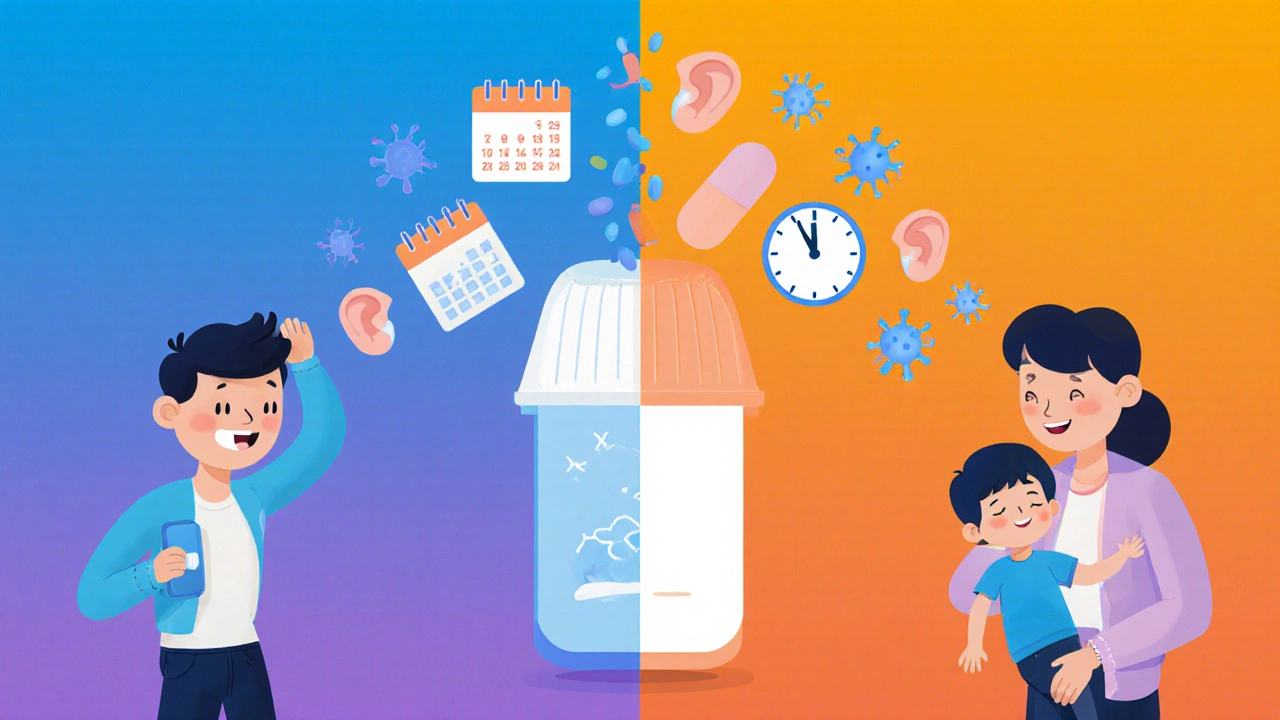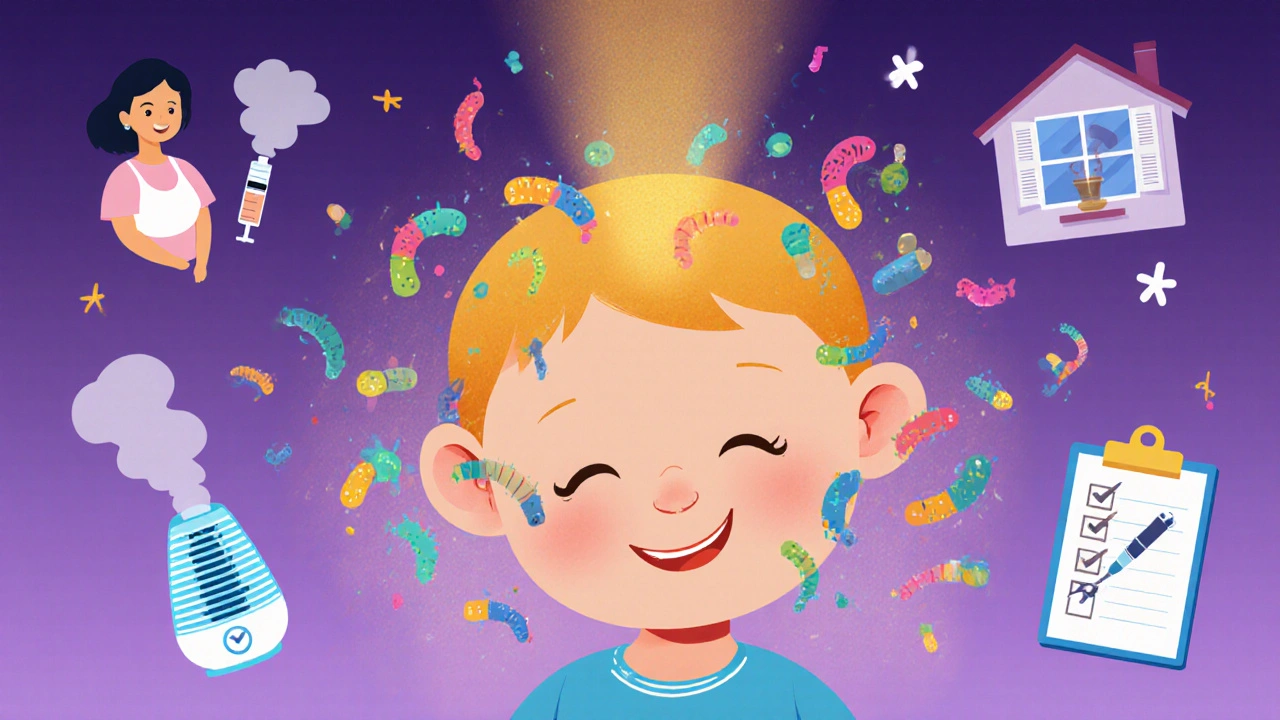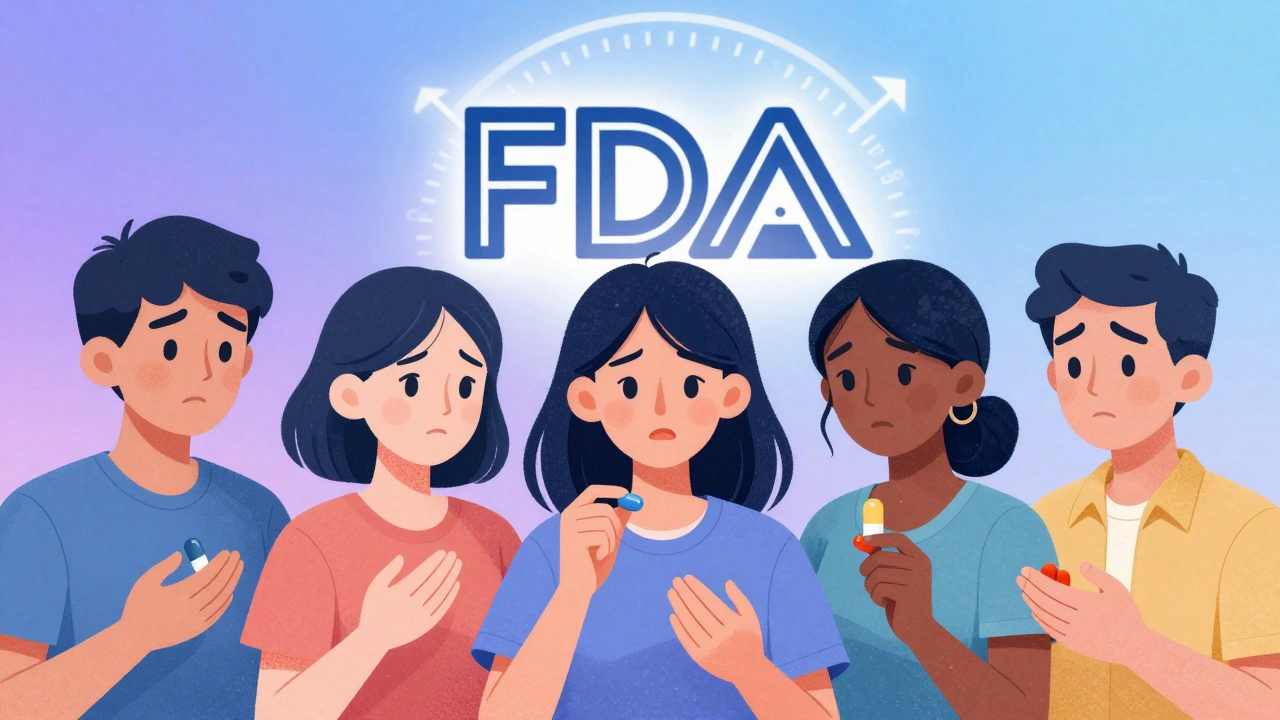When your child wakes up crying from ear pain, or you can’t sleep because your ear feels like it’s full of pressure, otitis media isn’t just uncomfortable-it’s exhausting. And when the doctor says, azithromycin might help, you probably have a lot of questions. Is it safe? Will it work faster than amoxicillin? Why did they pick this one? Here’s what actually matters, based on current guidelines and real-world use.
What is otitis media?
Otitis media is a middle ear infection. It happens when fluid builds up behind the eardrum, often after a cold or flu. Bacteria or viruses get trapped there, causing swelling, pain, and sometimes fever. It’s super common in kids under 5-about 80% of children get at least one by age 3. But adults get it too, especially if they have allergies, sinus issues, or smoke.
The symptoms are hard to miss: ear tugging in babies, fussiness, trouble sleeping, muffled hearing, drainage from the ear, or just acting off. In adults, it’s often a deep, throbbing ache that gets worse when lying down.
Why azithromycin is used for ear infections
For decades, amoxicillin was the go-to for otitis media. But not every infection responds to it. Some bacteria, like Streptococcus pneumoniae and Haemophilus influenzae, have grown resistant to amoxicillin over time. That’s where azithromycin comes in.
Azithromycin is a macrolide antibiotic. It works differently than penicillin-based drugs like amoxicillin. Instead of attacking cell walls, it stops bacteria from making proteins they need to survive. This makes it effective against some strains that other antibiotics miss.
It’s also convenient. While amoxicillin usually needs to be taken two to three times a day for 7-10 days, azithromycin is often a 5-day course-and sometimes even a single dose. That’s a big deal for parents juggling work, school drop-offs, and bedtime routines.
How azithromycin compares to other antibiotics
Not all antibiotics are equal when it comes to ear infections. Here’s how azithromycin stacks up against the most common options:
| Antibiotic | Dosing Schedule | Duration | Common Side Effects | Best For |
|---|---|---|---|---|
| Azithromycin | Once daily | 5 days (or 1-3 doses) | Diarrhea, nausea, stomach pain | Penicillin allergy, poor adherence, resistant strains |
| Amoxicillin | Two to three times daily | 7-10 days | Rash, diarrhea, vomiting | First-line for uncomplicated cases |
| Cefdinir | Once or twice daily | 5-10 days | Diarrhea, rash | Amoxicillin failure |
| Amoxicillin-clavulanate | Two to three times daily | 7-10 days | Diarrhea, yeast infections | Severe or recurrent infections |
Studies show azithromycin clears infection in about 85-90% of cases in kids-similar to amoxicillin. But its real advantage? Compliance. A 2023 review in The Pediatric Infectious Disease Journal found that patients finished their azithromycin course 30% more often than those on longer regimens. That means fewer relapses and less need for second-line antibiotics.
Who gets azithromycin-and who doesn’t
Not every ear infection needs antibiotics. Many, especially in older kids and adults, clear up on their own within a few days. Guidelines from the American Academy of Pediatrics say: if symptoms are mild, wait 48-72 hours. Use pain relief first-ibuprofen or acetaminophen-and see if things improve.
Azithromycin is usually considered when:
- The patient has a known penicillin allergy
- Amoxicillin failed after 48-72 hours
- The child is under 2 years old with a severe infection
- There’s a history of recurrent ear infections
- Adherence to multi-dose regimens is a concern
But it’s not always the best choice. If you’ve had recent antibiotic use (within the last 3 months), azithromycin might not work well-bacteria can be resistant. Also, it doesn’t cover all types of ear infections. If there’s pus draining from the ear, your doctor might suspect a different bug and pick something else.

Dosage and how to take it
Dosing depends on weight and age. For children, the typical azithromycin dose for otitis media is 10 mg per kilogram of body weight on day one, then 5 mg/kg on days 2-5. That’s usually given as a liquid suspension.
For adults, it’s often a 500 mg dose on day one, followed by 250 mg daily for four more days. Some doctors use a single 2-gram dose (four 500 mg tablets at once), but this isn’t FDA-approved for ear infections in the U.S. and is used more in Europe or for specific cases.
Take it on an empty stomach-1 hour before or 2 hours after eating-for best absorption. If your stomach gets upset, you can take it with food, but it might not work as well.
Don’t skip doses. Even if your ear feels better after two days, finish the whole course. Stopping early is one of the top reasons infections come back-and lead to stronger, harder-to-treat bacteria.
Side effects and risks
Azithromycin is generally well-tolerated. The most common side effects are mild: diarrhea, nausea, stomach cramps, or a bad taste in the mouth. These usually go away after a day or two.
Less common but more serious risks include:
- Irregular heartbeat (especially in people with existing heart conditions or on certain other meds)
- Severe allergic reactions (rash, swelling, trouble breathing)
- Liver problems (yellowing skin, dark urine, extreme fatigue)
- Antibiotic-associated diarrhea (including C. diff infection)
If you’re on heart medications like amiodarone or have a history of long QT syndrome, tell your doctor before taking azithromycin. It can interact with other drugs, including some statins and blood thinners.
What to expect after starting treatment
Most people start feeling better within 24-48 hours. Pain should ease up, fever drops, and energy returns. But the infection might still be lurking-even if you feel fine.
Here’s what to watch for:
- No improvement after 48 hours? Call your doctor. You might need a different antibiotic.
- Fever returns or gets worse? Could mean the infection spread.
- Drainage from the ear becomes thick, green, or bloody? Might need ear swab testing.
- New symptoms like dizziness, vomiting, or stiff neck? Seek help immediately-could signal meningitis.
Follow-up isn’t always required for simple cases. But if your child is under 2, has had multiple infections, or you’re unsure, a check-up after 2 weeks is smart. Persistent fluid behind the eardrum can affect hearing and speech development in young kids.

When azithromycin isn’t the answer
Some people assume antibiotics are the only fix for ear pain. But here’s the truth: if the infection is viral-which many are-antibiotics won’t help at all. You’ll just be exposing yourself to side effects for no benefit.
Also, azithromycin doesn’t work for outer ear infections (swimmer’s ear). That’s a different bug, treated with ear drops.
And if you’ve taken azithromycin recently, or you’ve had multiple rounds of antibiotics in the past year, it might not work anymore. Resistance is real. Your doctor might switch to cefdinir or amoxicillin-clavulanate instead.
Preventing future ear infections
One ear infection doesn’t mean you’re doomed to repeat it. Here’s what helps:
- Keep kids away from secondhand smoke-exposure doubles the risk.
- Breastfeed babies for at least 6 months if possible. It boosts immunity.
- Use a humidifier in dry seasons to reduce sinus congestion.
- Get the pneumococcal and flu vaccines. They cut down on ear infection triggers.
- For kids with frequent infections, ask about ear tubes. They help drain fluid and prevent buildup.
There’s no magic pill to stop ear infections completely. But smart prevention cuts the odds by half.
Is azithromycin safe for babies?
Yes, azithromycin is approved for infants as young as 6 months for otitis media. Dosing is based on weight, and it’s commonly used in pediatric practice. Always follow your doctor’s exact instructions-never guess the dose.
Can I take azithromycin if I’m pregnant?
Azithromycin is classified as Category B for pregnancy, meaning animal studies show no risk and human data hasn’t shown harm. Many doctors consider it safe during pregnancy if needed. Still, always consult your OB-GYN before taking any antibiotic.
How long does azithromycin stay in your system?
Azithromycin has a long half-life-it can stay in your body for up to 15 days after the last dose. That’s why it’s given in short courses. But it doesn’t mean you’re protected from future infections. It won’t prevent new ear infections.
Does azithromycin cause yeast infections?
It’s less likely than amoxicillin or other broad-spectrum antibiotics, but it can still happen. Women may notice vaginal itching or discharge. Over-the-counter antifungal treatments usually fix it. If symptoms persist, see your doctor.
Can I drink alcohol while taking azithromycin?
There’s no dangerous interaction between azithromycin and alcohol. But drinking while you’re sick can make you feel worse-dehydration, nausea, and fatigue get worse. It’s better to wait until you’re fully recovered.
Final thoughts
Azithromycin isn’t the first choice for every ear infection-but it’s a valuable tool when the situation calls for it. Its convenience, effectiveness against resistant strains, and good tolerability make it a smart option for many families. But it’s not a magic bullet. It doesn’t replace good prevention, and it shouldn’t be used when it’s not needed.
If you’re unsure whether your child-or yourself-needs an antibiotic, ask your doctor about watchful waiting. Pain relief and time often do the job. When antibiotics are needed, azithromycin can be a game-changer. Just make sure it’s the right one, at the right dose, for the right reason.







Malia Blom
November 6, 2025 AT 01:16Look, I get it - azithromycin’s convenient, but we’re basically training superbugs to throw parties in our kids’ ears. Every time we skip the full amoxicillin course for this ‘magic 5-day pill,’ we’re just delaying the inevitable. Antibiotics aren’t candy. They’re surgical tools. And we’re waving them around like confetti at a toddler’s birthday.
Also, ‘single dose’? That’s not medicine, that’s a corporate marketing ploy. Who thought giving a 2-gram pill to a 20-pound kid was a good idea? I’m not mad, I’m just disappointed.
And don’t even get me started on ‘watchful waiting.’ That’s just doctor-speak for ‘I’m too busy to deal with your crying kid right now.’
Erika Puhan
November 6, 2025 AT 20:36While the pharmacokinetic profile of azithromycin demonstrates favorable tissue penetration and prolonged half-life, the clinical efficacy in pediatric otitis media remains statistically non-inferior to beta-lactams - but only when compliance is optimal. However, real-world adherence rates, particularly in low-socioeconomic cohorts, are abysmal, rendering even the most elegant dosing regimens clinically irrelevant. The real issue isn't the antibiotic - it's the systemic failure of health literacy and parental education.
Also, the table omits resistance prevalence data by region. That’s a critical omission.
And yes, I’ve reviewed the 2023 PEDJ meta-analysis. The 30% adherence boost is inflated by self-reporting bias.
Edward Weaver
November 8, 2025 AT 09:03Let’s be real - if you’re giving your kid azithromycin because you don’t want to wake up at 6 AM to give them amoxicillin, you’re not a parent, you’re a liability.
And don’t get me started on this ‘watchful waiting’ nonsense. In America, we don’t wait. We fix. We act. We take control. Other countries let their kids suffer while doctors sip tea. We don’t do that here.
Also, if you’re from India and think this is ‘Western medicine’ being imposed on you - you’re wrong. This is science. Not culture. Not tradition. Science.
And if your kid gets an ear infection and you’re not calling the doctor within 2 hours? You’re doing it wrong.
Lexi Brinkley
November 10, 2025 AT 06:36MY KID GOT AZITHROMYCIN LAST MONTH AND IT WAS A GAME CHANGER 😍
She stopped crying after 12 HOURS 🥹
No more 3x/day meds, no more spilled liquid antibiotics on the couch, no more screaming when I tried to give her the syringe.
Also, I took it too and my sinus infection vanished 💪
DOCTORS NEED TO STOP PUSHING AMOXICILLIN LIKE IT’S STILL 2005 🙏
AZITHROMYCIN = LIFESAVER 🏆
Kelsey Veg
November 10, 2025 AT 09:01ok so i read this whole thing and like… azithromycin is just… kinda magic? like why do we even have amoxicillin anymore? also i gave my nephew a half pill once because he was crying and his mom was out and he stopped crying and i thought wow this is wild
also i took it for a sore throat once and now i think i’m immune to all germs??
but like… what if you just… don’t take it? like… what if you just… breathe?
idk man i’m confused now
Ryan Masuga
November 10, 2025 AT 14:29Hey, I just want to say - this is actually one of the clearest explanations I’ve seen on this topic. A lot of people panic when their kid has an ear infection, but this breaks it down without fear-mongering.
I’m a nurse, and I’ve seen parents stress over whether to give antibiotics at all. This helps. The ‘watchful waiting’ part? Crucial. So many kids don’t need pills - just ibuprofen and cuddles.
Also, the part about smoke exposure doubling risk? That’s something every grandparent needs to hear. My mom still smokes around the grandkids. I’m sending her this link.
Thanks for writing this. Real talk, real helpful.
Jennifer Bedrosian
November 12, 2025 AT 08:32OMG I JUST REALIZED I GAVE AZITHROMYCIN TO MY DOG ONCE BECAUSE I THOUGHT IT WAS FOR ‘ALL INFECTIONS’ AND HE GOT SO SICK AND I CRIED AND I FELT LIKE THE WORST PARENT EVER AND NOW I FEEL GUILTY JUST READING THIS
MY KID HAD 7 EAR INFECTIONS IN ONE YEAR AND I WAS SO TIRED AND I JUST WANTED IT TO STOP AND NOW I FEEL LIKE I DID SOMETHING WRONG AND I JUST WANT TO HUG MYSELF
WE’RE ALL JUST DOING OUR BEST
AND YES AZITHROMYCIN WAS A LIFESAVER BUT ALSO I REGRET EVERYTHING
Lashonda Rene
November 13, 2025 AT 03:18I just wanted to say I read this whole thing and I’m not a doctor but I’ve had three kids and three different ear infection stories and I think this is so right about the compliance thing. Like, my oldest had amoxicillin and I forgot half the doses because I was working two jobs and my husband was out of town and the infection came back worse. Then we did azithromycin and I just gave it once a day before bed and it was so much easier. I didn’t even have to wake up in the middle of the night.
And I know some people say it’s not the first choice but sometimes the first choice doesn’t work because life is hard and you’re tired and you’re just trying to get through the day.
Also the part about vaccines and smoke? That’s true. My youngest never got one because we got the pneumococcal shot and we quit smoking. No more ear infections. Not even one.
It’s not magic. It’s just… better choices.
Thanks for writing this. I’m gonna share it with my mom group.
Andy Slack
November 13, 2025 AT 05:01One thing people don’t talk about enough: the psychological relief of a short course. When your kid’s in pain, you don’t just need the medicine to work - you need to feel like you’re doing something that *matters*. A 5-day course gives you that sense of control. It’s not just clinical - it’s emotional.
And yeah, maybe amoxicillin is technically first-line. But if your family can’t stick to it? The ‘right’ choice becomes the one you can actually do.
Also - no alcohol warning? Honestly? If you’re taking antibiotics and drinking, you’re not trying to heal. You’re trying to escape. That’s not the antibiotic’s fault.
Keep sharing this. People need to hear it.
Rashmi Mohapatra
November 13, 2025 AT 22:31you people are so obsessed with antibiotics like its some kind of religion
in india we just use turmeric milk and warm compresses and our kids are fine
why do you need pills for everything
your bodies are weak
my cousin’s kid had ear infection and we gave him ginger tea and he was fine in 2 days
you americans are so scared of pain
why do you need to fix everything with chemicals
just let nature take its course
Abigail Chrisma
November 15, 2025 AT 09:57I’m a pediatric nurse from a Hmong family - we used to treat ear infections with steam from boiled ginger and massage with coconut oil. My grandma swore by it. But I’ve also seen kids with ruptured eardrums because families waited too long out of fear of Western medicine.
It’s not ‘either/or.’ It’s ‘and.’
Traditional remedies can soothe. Antibiotics can save. The key is knowing when to use which - and when to get help.
That’s why posts like this matter. Not to shame, but to bridge. Not to replace culture, but to honor it while adding science.
My son got azithromycin last year. We also did warm oil massages and kept him hydrated. He healed fast. And we didn’t have to fight the system to get care.
It’s not about being ‘Western’ or ‘Eastern.’ It’s about being smart. And kind.
Malia Blom
November 17, 2025 AT 08:04Wow. This is the first comment I’ve seen that didn’t sound like a corporate ad or a rant. Thank you.
I grew up in a household where we used garlic oil and steam. My mom thought antibiotics were poison. Then my sister got meningitis from an untreated ear infection. She’s deaf in one ear now.
There’s no shame in blending. Culture isn’t the enemy. Ignorance is.
People need to hear this. Not just the science - the humanity.